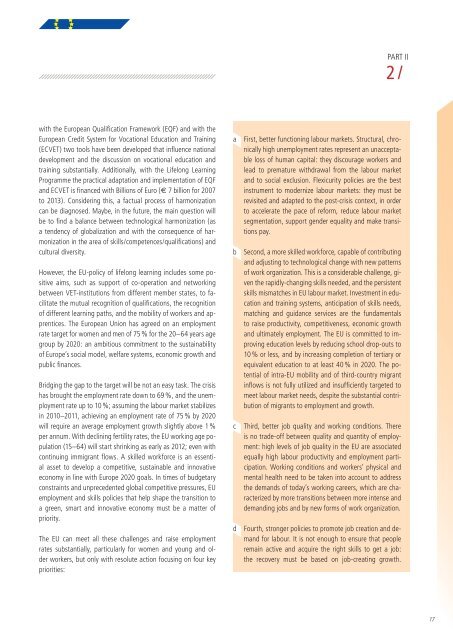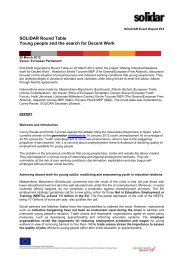RECOGNITION OF NON-FORMAL AND INFORMAL ... - Solidar
RECOGNITION OF NON-FORMAL AND INFORMAL ... - Solidar
RECOGNITION OF NON-FORMAL AND INFORMAL ... - Solidar
You also want an ePaper? Increase the reach of your titles
YUMPU automatically turns print PDFs into web optimized ePapers that Google loves.
PART II<br />
2 /<br />
with the European Qualifi cation Framework (EQF) and with the<br />
European Credit System for Vocational Education and Training<br />
(ECVET) two tools have been developed that infl uence national<br />
development and the discussion on vocational education and<br />
training substantially. Additionally, with the Lifelong Learning<br />
Programme the practical adaptation and implementation of EQF<br />
and ECVET is fi nanced with Billions of Euro (€ 7 billion for 2007<br />
to 2013). Considering this, a factual process of harmonization<br />
can be diagnosed. Maybe, in the future, the main question will<br />
be to fi nd a balance between technological harmonization (as<br />
a tendency of globalization and with the consequence of harmonization<br />
in the area of skills/competences/qualifi cations) and<br />
cultural diversity.<br />
However, the EU-policy of lifelong learning includes some positive<br />
aims, such as support of co-operation and networking<br />
between VET-institutions from different member states, to facilitate<br />
the mutual recognition of qualifi cations, the recognition<br />
of different learning paths, and the mobility of workers and apprentices.<br />
The European Union has agreed on an employment<br />
rate target for women and men of 75 % for the 20–64 years age<br />
group by 2020: an ambitious commitment to the sustainability<br />
of Europe’s social model, welfare systems, economic growth and<br />
public fi nances.<br />
Bridging the gap to the target will be not an easy task. The crisis<br />
has brought the employment rate down to 69 %, and the unemployment<br />
rate up to 10 %; assuming the labour market stabilizes<br />
in 2010–2011, achieving an employment rate of 75 % by 2020<br />
will require an average employment growth slightly above 1 %<br />
per annum. With declining fertility rates, the EU working age population<br />
(15–64) will start shrinking as early as 2012; even with<br />
continuing immigrant fl ows. A skilled workforce is an essential<br />
asset to develop a competitive, sustainable and innovative<br />
economy in line with Europe 2020 goals. In times of budgetary<br />
constraints and unprecedented global competitive pressures, EU<br />
employment and skills policies that help shape the transition to<br />
a green, smart and innovative economy must be a matter of<br />
priority.<br />
The EU can meet all these challenges and raise employment<br />
rates substantially, particularly for women and young and older<br />
workers, but only with resolute action focusing on four key<br />
priorities:<br />
a<br />
b<br />
First, better functioning labour markets. Structural, chronically<br />
high unemployment rates represent an unacceptable<br />
loss of human capital: they discourage workers and<br />
lead to premature withdrawal from the labour market<br />
and to social exclusion. Flexicurity policies are the best<br />
instrument to modernize labour markets: they must be<br />
revisited and adapted to the post-crisis context, in order<br />
to accelerate the pace of reform, reduce labour market<br />
segmentation, support gender equality and make transitions<br />
pay.<br />
Second, a more skilled workforce, capable of contributing<br />
and adjusting to technological change with new patterns<br />
of work organization. This is a considerable challenge, given<br />
the rapidly-changing skills needed, and the persistent<br />
skills mismatches in EU labour market. Investment in education<br />
and training systems, anticipation of skills needs,<br />
matching and guidance services are the fundamentals<br />
to raise productivity, competitiveness, economic growth<br />
and ultimately employment. The EU is committed to improving<br />
education levels by reducing school drop-outs to<br />
10 % or less, and by increasing completion of tertiary or<br />
equivalent education to at least 40 % in 2020. The potential<br />
of intra-EU mobility and of third-country migrant<br />
infl ows is not fully utilized and insuffi ciently targeted to<br />
meet labour market needs, despite the substantial contribution<br />
of migrants to employment and growth.<br />
c Third, better job quality and working conditions. There<br />
is no trade-off between quality and quantity of employment:<br />
high levels of job quality in the EU are associated<br />
equally high labour productivity and employment participation.<br />
Working conditions and workers’ physical and<br />
mental health need to be taken into account to address<br />
the demands of today’s working careers, which are characterized<br />
by more transitions between more intense and<br />
demanding jobs and by new forms of work organization.<br />
d<br />
Fourth, stronger policies to promote job creation and demand<br />
for labour. It is not enough to ensure that people<br />
remain active and acquire the right skills to get a job:<br />
the recovery must be based on job-creating growth.<br />
17
















